September 2018
Why did the Leopard Cross the Road
Join us for a week in Kruger National Park
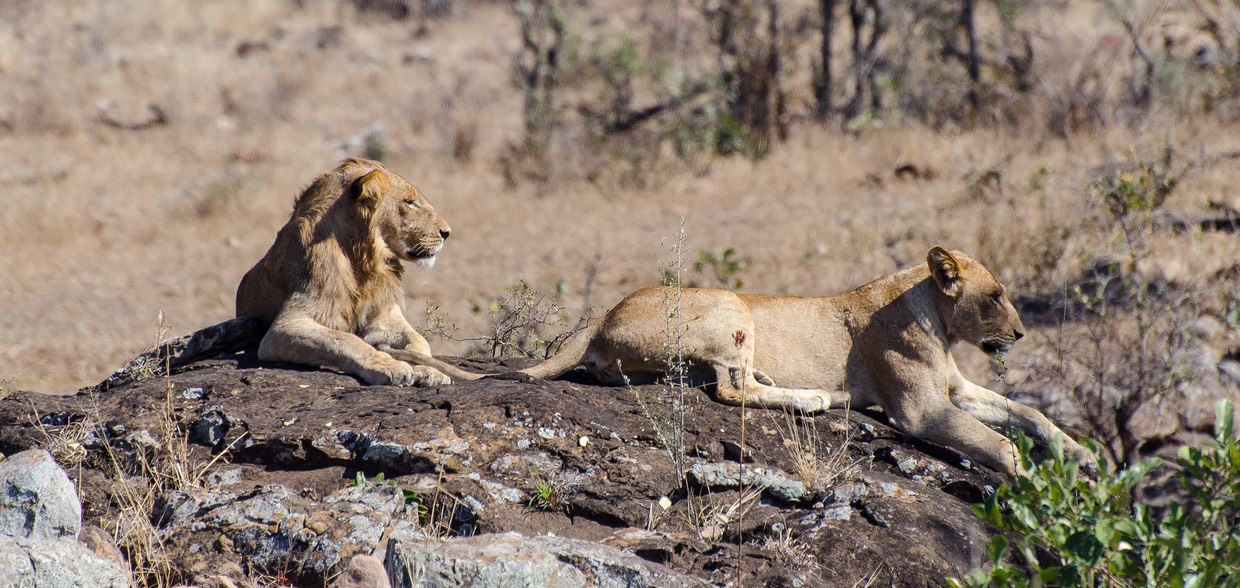
“So”, I asked Rick a couple of years back, “what’s most important for you to see in Africa?” “The animals, of course” he replied. There was more to it than that, naturally — a whole lot more. But the ability to be this close to a lion, or a leopard, and have them ignore you and carry on with their lives in the wild; that’s pretty special. And a big reason why we are here.
We’d already seen huge amounts of animals during our brief in Africa, but in South Africa, the biggest single draw on the wild animal front is probably Kruger National Park in the north east corner of the country. It’s certainly the best known, the largest, and has an enormous concentration of all the critters you want to see — elephants, giraffes, zebras, rhinos, hippos, baboons and monkeys, numerous kinds of antelopes, birds everywhere, to say nothing of the aforementioned cats of all sizes and colors. So naturally we needed to go there.
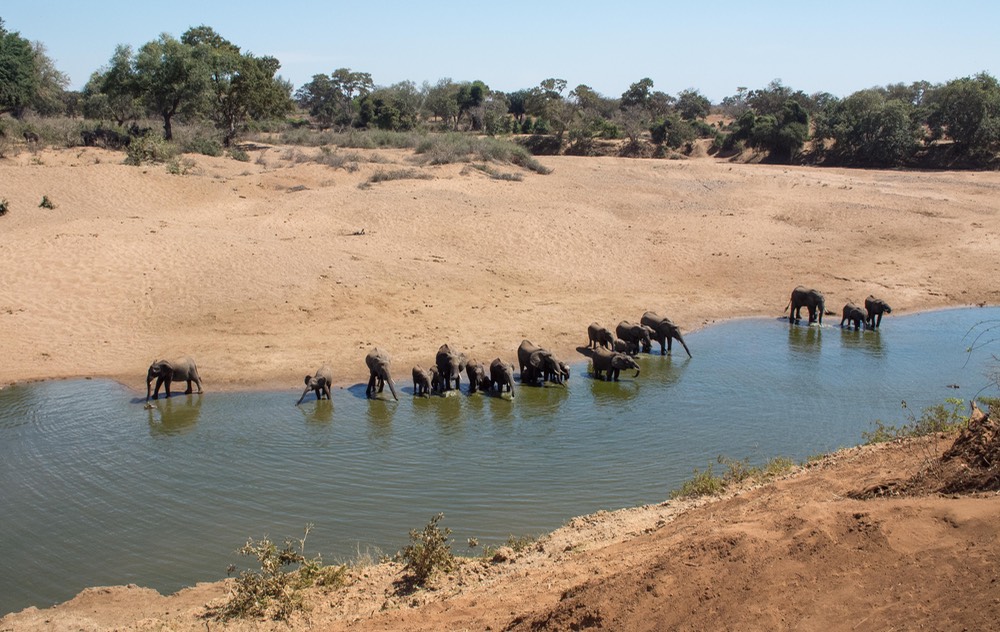
We’ve just finished a bit over a week in Kruger, have produced at least a thousand photos between the two of us (some of them quite extraordinary), driven 650 kilometers, with 325 of those, or just half of them, on gravel, met some great new friends, seen a baby Nyala just as it was being born (a kind of antelope), and had a very, very good time. So! When are you coming?
Going to Kruger NP is a major project, although well worthwhile. The first thing is to decide how long to stay. You really do have to book your overnight spots ahead of time. We wanted to camp, of course, and there are plenty of campgrounds (and lodges for non-campers), but all of them are popular. So you need to look on a map and try to organize your route so that you aren’t driving too far between stops. Otherwise all you are doing is driving because Kruger is big and the speed limit on pavement is only 50km/hour; and on gravel it’s 40 km/hour but you are often going only 20-30. This gets to be pretty slow if you’re feeling pressured to cover ground.
In an ideal world we’d recommend a stay of about two weeks to be about right, if you can manage it, with 3 nights at each of your stops. This way you can take a day off now and then, and still be able to do all the game drives that you would like. There’s no such thing as a bad game drive. You do see animals while on pavement, but the greater opportunities come when you are on gravel, and all this is quite time-consuming.
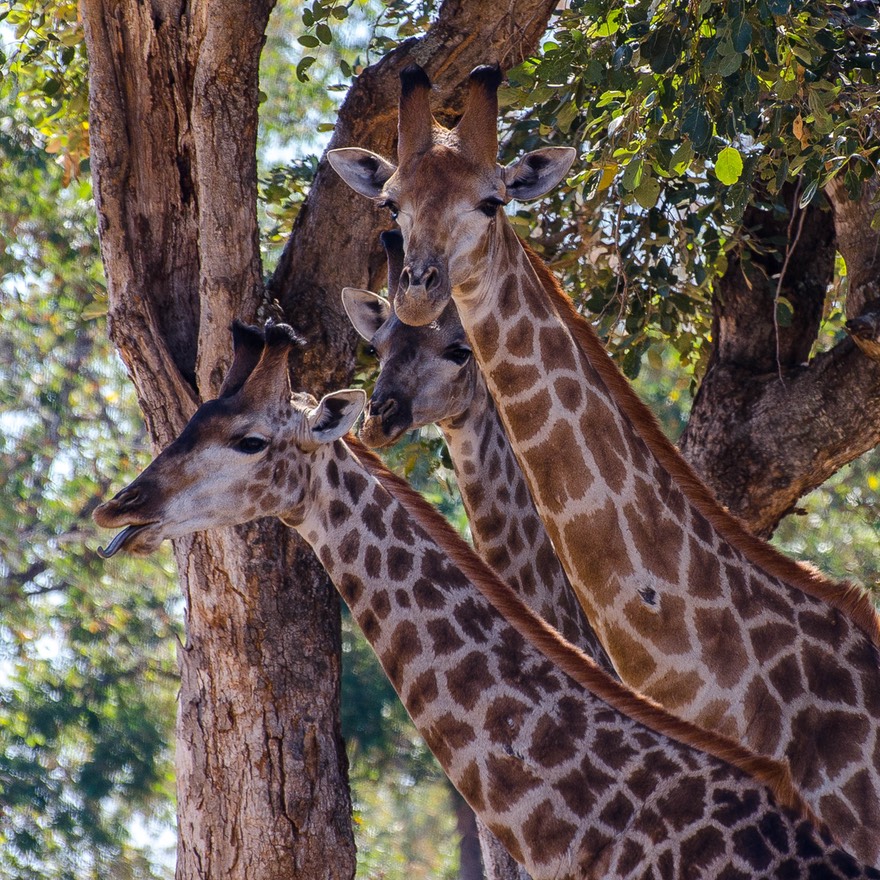
Something we sort of expected but really came to know to be true is that you will find many, many more people in the southern part of the park than in the north. The rest camps and lodges are much larger, there are more of them and they are more popular because they are much closer to major population centers; we even encountered tour buses. We’d been told that there are also more animals in the south, and this is also true. But we would still choose to spend more time in the north, say from Letaba north, over the south anytime because of the greatly increased ability to feel that you are out exploring on your own and not following a bunch of other folks around. A further thought: with the exception of our leopard sighting, and rhinos, which we’d seem numerous times before, our first Kruger sighting of every animal occurred either at Punda Maria or Letaba, i.e., in the northern part of the park.
The timing of any trip to Kruger is driven by the weather. (Every decision you make in Africa has to do with the weather, it appears.) September is coming up to the end of the dry season, and it has been very hot, very dry and dusty, and not our favorite time to do much of anything. However — the game-viewing is terrific. The animals congregate near water, and by now the rivers and waterholes are drying up. So there are lots of excellent opportunities for wildlife viewing. After the wet season, the landscape will be lush and green and the rivers will be high (and we suspect will close some of the game drives). But the animals? Fat and happy, hidden in the brush and harder to find. So here we are; but we really want to see if we can come back next year along about April-May, after the worst of the wet.
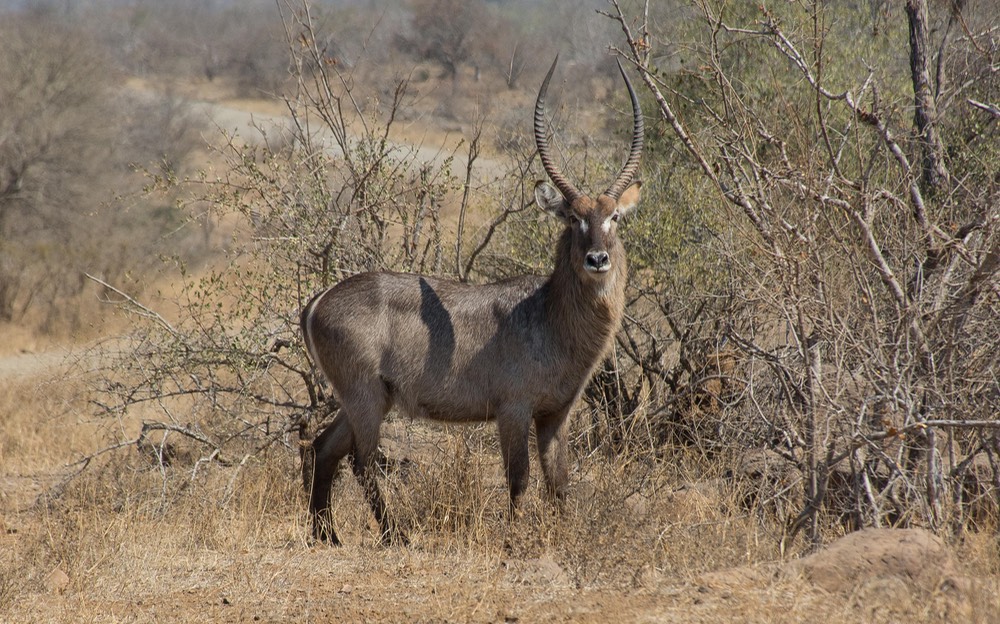
Kruger is oriented on a North-South axis, and is about 360 kms long from top to bottom; overall it’s just a little smaller than Yellowstone NP in the US. We’d planned to see Kruger right after coming out of Swaziland, but when we became convinced that we really did have to book ahead we found we were unable to arrange campground reservations until about the first of September — about two weeks off. You could get a night, and then maybe a night a ways away, but that’s not a good way to travel. August is a major vacation time, and the parks were filled up.
Starting early September, however, things would open up a bit. So we did other sightseeing while we waited; all covered in our previous message. We still couldn’t do whatever we wanted to, but were able to book 2 nights at Punda Maria, 3 nights at Letaba, 2 nights at Skukuza, and our last night in the park we stayed at Berg-en-Dal, down near one of the southern exits from the park. Bookings were a bit more open in the north, which many visitors never go to, so our plan was to start up at the top and work our way to the southern border.
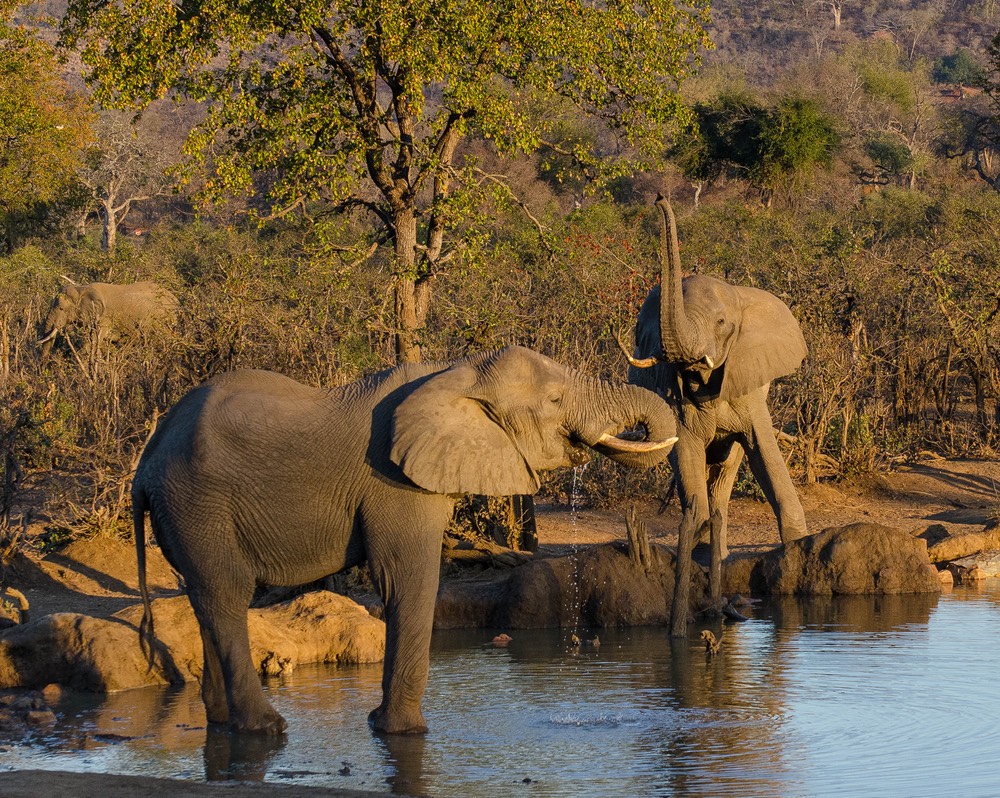
Punda Maria is a small camp in the far northern part of the park, and is a super place to get started on your adventure; we really liked it here. There is a waterhole/hide right on the edge of the camp, and there are plenty of elephants nearby. A neighbor in the camp said that a couple of nights previous to our arrival there had been four leopards hanging out during the evening. The photo to the right was taken from the hide at the Punda Maria campsite.
The next day we headed north to an area we’d been told was really great, and was it ever. About 30 kms into our first gravel game drive we were treated to our first sighting of lions. Wow! There were five or six of them lounging, almost posing it seemed, on some rocks not far from the road. The sunlight was even in a good place. It could not have been more perfect. We have a traditional little conversation that we share at times like this: Rick asks, “Do I?” And Kathy answers, “Yes, you do.” The understood end of the question is, “…take you cool places, or what?” Well this was a cool place for sure.
Later in the day we were following a trail of small branches littering the road, with dung clumps hither and yon (we call all this elephantritis, of course)….then suddenly we came on a huge elephant at a waterhole covering himself in mud. Soon the rest of the group showed up; he appeared to be taking exception to us so we backed away and moved on. Awesome!
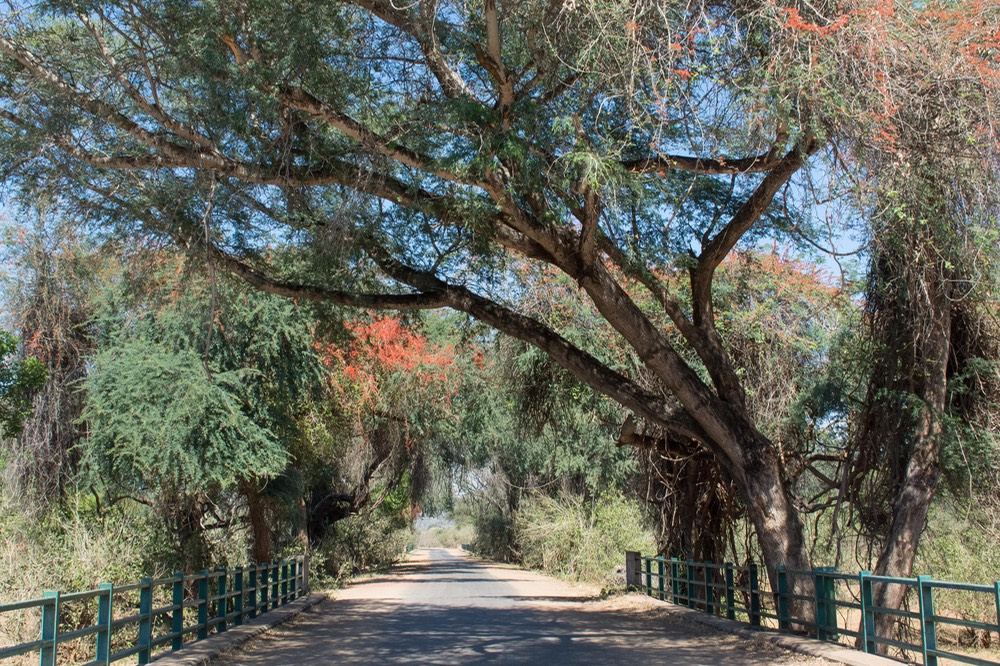
Still in the Punda Maria area, we drove out along the Luvuvhu River over to where it meets the Limpopo River — where South Africa, Zimbabwe and Mozambique all come together. This is a great river drive. Oh, and there are baobab trees up this far north. You remember the boabs in Australia, don’t you? A near cousin and just as funny looking.
Heading south toward Letaba Rest Camp we crossed the Tropic of Capricorn. There was a nice small monument to the fact, with some helpful information. We were pleased, as we crossed it earlier as we were heading north to the park entry, but at that point the monument was a real dud. We also took a couple of outstanding game drives, one north of the Mopani rest camp and the other just a bit south of there. We had wonderful viewing on both drives, particularly of elephants and giraffe but also much more.
Letaba is sort of mid-way down through Kruger, and a nice spot. It’s a large facility, although the camping here is very popular and it was full while we were there. Some locals were surprised at how busy it was. It seems a lot of South Africans that were camping in Kruger at this time had driven up from the Cape Town area — it was so cold down there they were looking for sunshine! We on the other hand had been hotter than we’d like and had begun thinking about heading for the Cape.
The campgrounds at Kruger NP do not have assigned spaces; several of them don’t even have spaces delineated at all. It’s more a case of finding a spot for yourself in the camping area, and spreading out enough so that you can retain that space as others filter in later in the evening. But everyone is happy to be there, cheerful with the sometimes tight quarters, and apologetic if they have to crowd you a bit and maybe ask for some guidance in how to get past you the next morning if they are leaving before you. The reservation process limits the number of campers so it isn’t a problem at all.
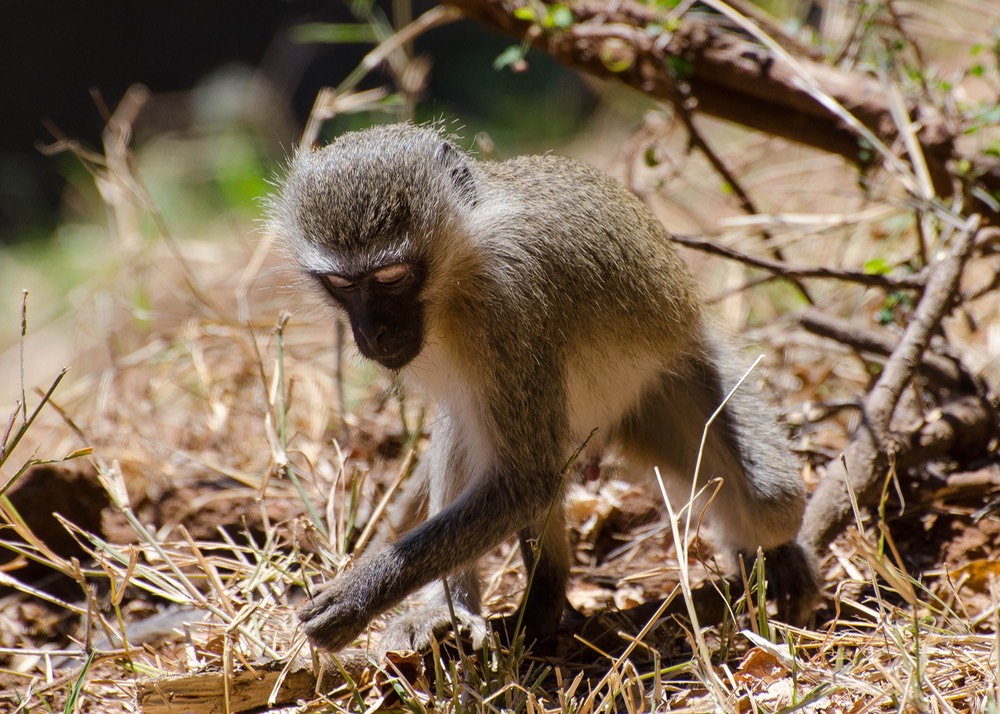
A small comment about arrival and departure times in the campgrounds. People who are anxious to get out and see the animals as early as possible get up and leave by about 6 am. People who are spending the day driving to a distant location are gone by 8:00. Those who are taking the day off are up but not moving around much until about 9:00. Then in the afternoon, the early birds are done and home by lunch; the rest dribble in late in the afternoon. The lodges, where visitors are more likely to be on a guided drive, seem more structured.
Some of campgrounds have resident monkeys and/or baboons and campers are cautioned not to feed them, not to pester them, etc. The trash cans are very complicated in order to defeat their ability to get at most anything that interests them — pretty much defeats me too! We had a great time watching the vervet monkeys playing on the various tents and awnings and other bouncy bits that people had as part of their camp site. Everything was a trampoline to the youngsters and they were great fun to watch.
So far we’ve not taken a guided drive in a game park. We knew ahead of time that if we were having trouble finding the animals and getting our fill of great experiences that we’d discuss the possibility. But it just never came up. We fully admit that our lifestyle doesn’t agree very well with getting ourselves gone by 6:00 in the morning. We’re always the last ones to leave — somewhere between 8:00 and 9:00 depending, and we might have seen more game had we gotten earlier starts. We saw so much on our own schedule that we’re not sure it would have mattered.
We took the middle day off while we were at Letaba and wandered around enjoying the facilities. There is an excellent museum that has a new fancy name now, but is traditionally known as the Elephant Hall. It was just great and we learned a whole bunch about these amazing animals. There were lots of displays and info panels on several of the “Magnificent Seven” big, beautiful elephants from earlier in the history of the park, represented by their stories — and their enormous tusks. They were quite a sight. Each of the campgrounds has a small, basic store and gift shop and restaurant and some laundry facilities. We found them both attractive and practical.
On our drive south to Skukuza, we came across a drive-clump. Somebody will see something (often a skilled spotter/driver on an official guided excursion). The open-air drive-wagon will stop. Others going by will slow, trying to see what the guide was looking at. This becomes a drive-clump. You’re caught; you cannot get by; you cannot see what’s going on until someone decides to leave, slows as they pass your stuck truck, and let’s you know what it’s all about.
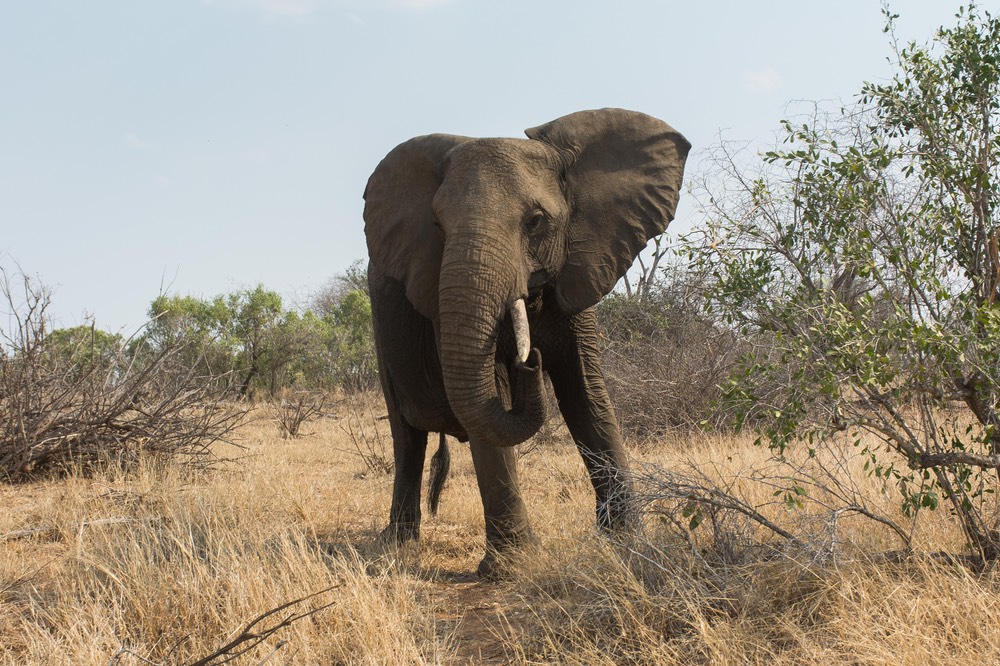
Sometimes exasperating, but sometimes very helpful. In this way we were able to spot a dead impala — a leopard’s “kill” — up in a tree where it had been parked until the cat got hungry again. Pretty interesting and we would never have seen it on our own! We saw a clump of sleeping lions this same way; they were off the road a way and in the shade. Actually Rick mostly did the seeing; he has the long lens on his camera and in this instance they were on his side. In case you ask, NO, you do not leave your vehicle to try to get a closer look — no way, no how.
Skukuza, our next stop, was a long drive; too long really but we hadn’t been able to get a reservation anywhere closer to Letaba. The site is located on a river, with an open-air restaurant under the trees and right along the water. It’s the park headquarters, the biggest facility at Kruger, and definitely has the nicest gift shop — there was some pretty cool stuff. This site also has a museum of the history of the park, with some very nice information and a large library.
We spent two nights there; this was important, as it’s in the middle of lots of routes to look for animals. We could have used more time. It was getting extremely hot by now, well over 100 degrees long before noon, and with less cooling down at night than we would have liked. We were still seeing game, but less; the heat was a bit much for them, too and we often spotted them lying in the shade wherever they could find it.
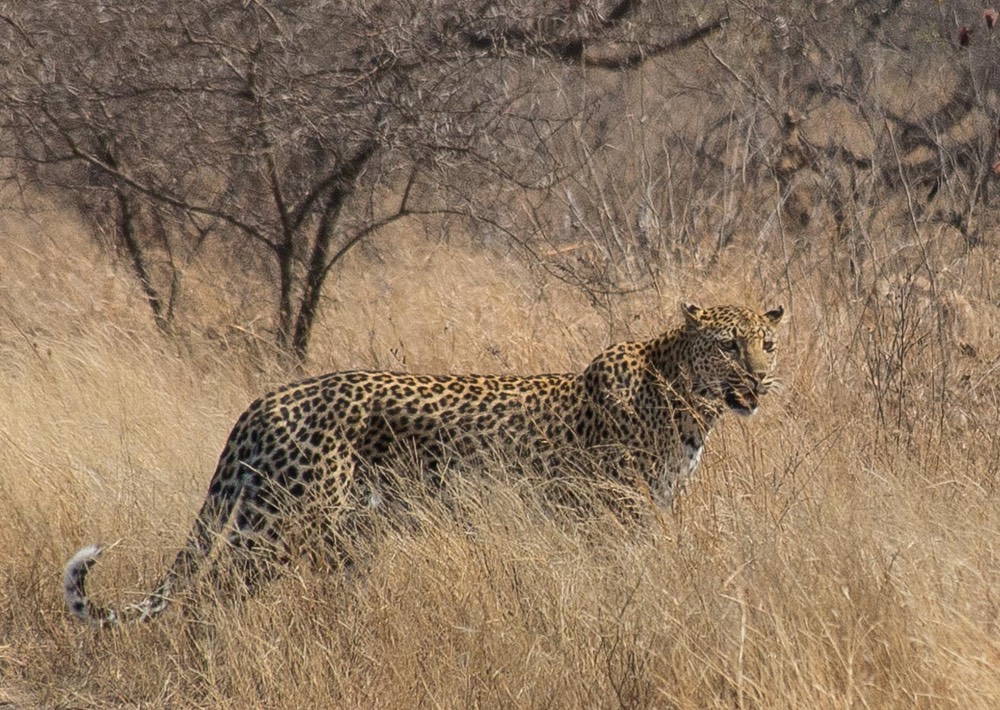
The very best thing we did while at Skukuza was to visit the Lake Panic game hide. It was on the edge of a large pond, and the birds were incredible. We saw an African darter catch a fish…and then eat it; incredible! There also were hippos and turtles and warthogs and a monitor lizard, and, and…. A terrific spot.
And then we saw the leopard…
(Why did the leopard cross the road? So we could take his picture, of course!)
Once again we were helped by a mini car-clump, but we don’t think we would have missed this guy. He was gorgeous and just sauntered along calmly going on about his business. Spectacular.
Our last night was at at Berg-en-Dal, in the southernmost part of the park — rhino country. By now we were ready to be on our way, but we did enjoy the site. The camping area was right on the edge of the compound, which was encircled by a fence to keep the rhinos out. Pretty cool, huh? Didn’t keep the mongoose hordes from coming through, though. These were miniature mongoose, and boy are they cute.
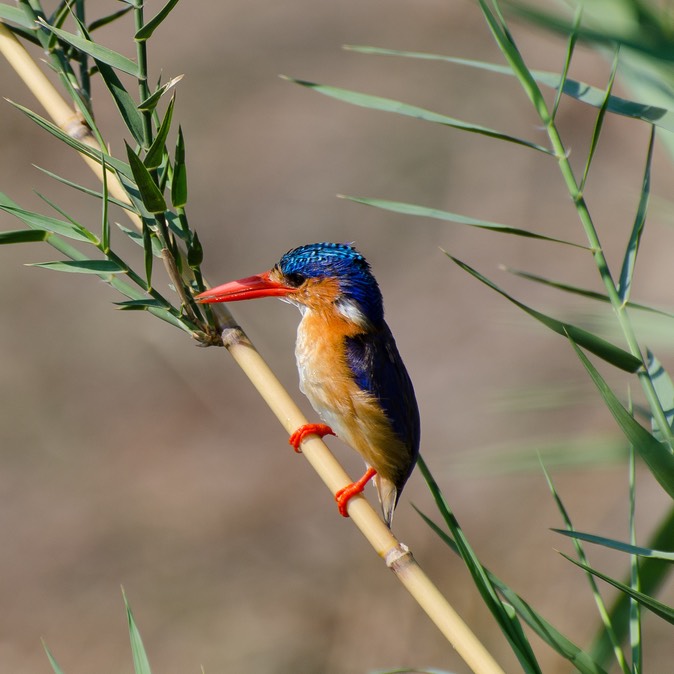
The next day we left the park and headed for Nelspruit and some badly needed shopping. We were back in “real” Africa, that’s for sure. We then collapsed back at the Lakeview Caravan Park for almost a week while we recuperated and worked on the pictures we’ve just posted for you on the website. Enjoy!
Our favorite memories? Driving along, with zebras to the left of us, impalas to the right, buffalo or baboons crossing the road, and a giraffe trimming the trees above. Or coming around a bend on a slow section and having to stop and then back off some because of the sudden appearance of a herd of elephant. The thing that kept coming to mind was how much it was like our visit to the Galapagos Islands. Being able to visit animals in their own natural space is such a wonderful gift we can give to ourselves when opportunities arise. During our week in Kruger we never tired of watching a giraffe stroll nonchalantly along trailed by her young, or hippos lounging on the grass or, more often, poking their ears, eyes and nostrils up out of the water, or elephants splashing about, or the amazingly beautiful variety of antelope or zebras. We’ve even begun to learn the names of some of the birds; like this little beauty, a malachite kingfisher.
Kruger has been simply a delightful experience and we gift you with these pictures in hopes they provide you with as much pleasure as we got from taking them.
Rick and Kathy and the Tiger, who’s hoping to see his people one of these days
Please go over to the Photo Page for this message to see the rest of the story.